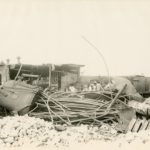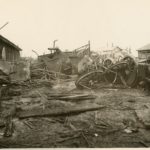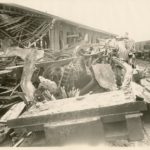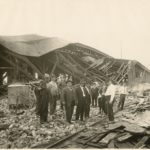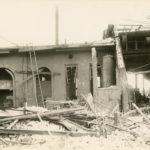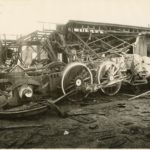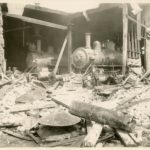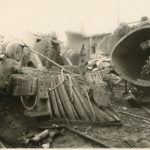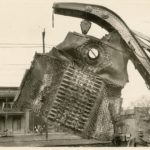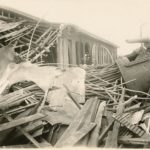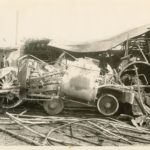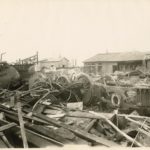The Great Locomotive Explosion:
a socio-historical examination of a tragedy
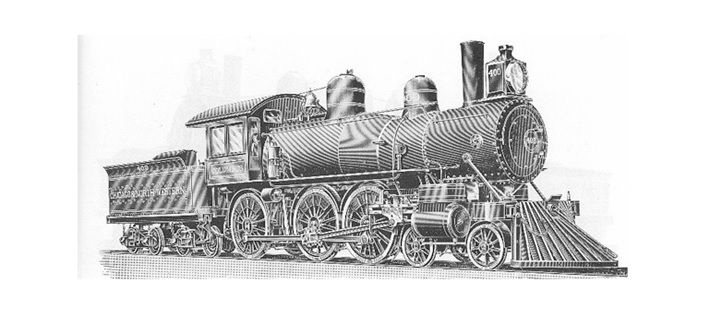
The following is an examination of the circumstances surrounding the great locomotive boiler explosion that occurred at the Southern Pacific Roundhouse in San Antonio, Texas. Particular attention will be paid to the social and political repercussions of the tragedy. The examination will be structured in three sections; the event, the investigation and the aftermath, followed by the author’s conclusions.
THE EVENT
It was morning, March 18, 1912. The city of San Antonio, Texas was awakening to a new day. On the East side of the city at 320 Milam Street, Mrs. Ellen Howard was walking towards the front of her house to get her mail. Mrs. August Peters of 1217 North Hackberry was standing in her yard. Mrs. A.P. McCall was walking across the yard of her residence on Mesquite Street. Mrs. E. O. Stephens at 115 Duval and Mrs. B.S. Gillis who resided in a large house at the corner of Mason and Austin streets, were both attending to morning chores in their respective homes.
Several blocks away, just outside of the Southern Pacific Roundhouse, near present day Interstate 35 and Austin Street, locomotive No.704, a modern “ten-wheeler” passenger engine of the Galveston, Harrisburg and San Antonio Railroad was being prepared for regular service. The engine had been involved in a train wreck in Seguin on December 18th, 1911 and the repairs had just been completed. As No.704 was needed for a run that evening, the order had been to “warm ‘er up”. Walter Jourdan, the engineer, an old hand and the most experienced trainman in the yard was moving in and around the locomotive making adjustments, checking fittings and generally preparing for movement out of the yard. Jose E. Fuentes, a shop painter, was painting a star insignia on the side of the engine’s driving rod.
Scores of men were working in the shops located to either side of the locomotive. Among these were Archie Price, a pipefitter’s helper, and P.J. Stoudt, a workman in the cooper shop. Henry C. Mansker Sr, foreman of the Blacksmith’s shop and his son James, a machinist, were standing within yards of each other. Robert Mantiel, a machinist’s helper was near the locomotive itself. The clock in the Machine shop indicated 8:55 AM. It would never reach 8:56.
A railroad locomotive of the steam era was a long cylindrical water boiler sitting on a wheeled carriage. A firebox, burning wood or coal was located immediately beneath the boiler. The steam pressure from the heated water operated a shaft which pushed a long horizontal bar attached to the driver wheels on each side of the locomotive. As the bars moved, they rotated the wheels. The locomotive moved and pulled its load by the sheer might of the steam pressure, overcoming the weight of the entire train.
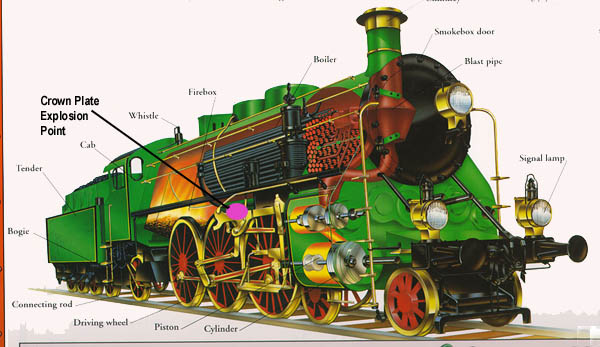
The maintenance and control of the amount of pressure within the boiler was critical. Various valves and devices had been developed which acted to channel and when necessary, release the pressure. The whistle on a steam locomotive is just such a pressure release device. Other valves were pre-set to “pop”, to begin releasing pressure, at varying limits in order to prevent an explosion. However, if the pressure became too great, too rapidly, the boiler’s heavy iron casing or “crown plate” could fail to contain it. Steamboat and railway boiler explosions were not uncommon in the 19th and early 20th Centuries. The explosion of the steamboat Sultana’s boiler in 1865 was the cause of the largest loss of life in US maritime history. Railroad passengers were rarely harmed by boiler explosions. It was the train crew that was almost always killed. The impending disaster at the Southern Pacific Roundhouse, was to be the greatest locomotive boiler explosion in the history of railway engineering.
Work at the railroad yard had not been all that pleasant recently. Labor problems had developed and a number of the boiler repairmen, copper fitters and other craftsmen necessary for the servicing of the large locomotives had been replaced since a walkout in the Fall of 1911. The Assistant Roundhouse Foreman, James Valentine, was openly carrying a pistol. Most of the men working in the blacksmith’s and machine shops within and near the roundhouse that morning, were new to the yard and to San Antonio. Several were recent arrivals from Pennsylvania, Ohio and New Jersey, while others were from towns in various parts of Texas. All had been brought in to replace long term employees that had stopped working, walked off the job, or been fired. Many of the men had been brought in so recently that they had yet to draw one pay check, their names were not recorded, many were working under assumed names and even the exact number of men in the yard was not known.
The Galveston, Harrisburg and San Antonio Railroad, as well as the parent Southern Pacific, was determined to keep service on time. No.704 had been tested the previous day and appeared serviceable. On this morning of the 18th the pressure valves had indicated a possible problem and the initial firing of the boiler had been stopped and the pressure allowed to drop. The boiler was then refired and the pressure was allowed to build a second time for the run out of the yard. Everything appeared normal and No.704 sat idling on the track, partially out of the roundhouse. It was at this point that the iron reinforcing bars supporting the “crown plate” of the boiler failed and the pressure was suddenly and catastrophically released.
In the space of an instant, the boiler began to split along its bottom. As the steam found an exit, the split widened, pushing and bending the walls of the cylinder outward, snapping the great wheels from their hubs, breaking the boiler from its carriage and launching the multi-ton cylinder skyward. Accompanying it were hundreds of pieces of engine accouterments, pipes, levers, rods, plate iron, grates, etc.
The pressure wave, moving outward from what had been the engine then struck the shops filled with working men. Buildings, structures and people on the ground in the immediate area of the engine were blown to pieces or if closer to the engine, simply disintegrated. As the pressure wave moved outward it carried away heavy equipment and structure walls causing the building roofs to collapse. This surface wave, carrying iron parts, splintered wood, human body parts and other debris, continued outwards from the railroad yard and through the surrounding neighborhoods, uprooting trees, snapping limbs, blasting out windows, and punching holes in residences.
Mrs. Peters, while standing at her gate was struck by an iron bolt, knocked unconscious and suffered internal injuries. Another homeowner, W. H. Witer, felt the crash of an object punching a hole in his house and upon investigation was horrified to find an entire human arm embedded in a rafter. Mrs. McCall stood, transfixed, as first, a mangled portion of a human corpse landed in her yard and then one of No.704’s auxiliary air tanks smashed down almost at her feet.
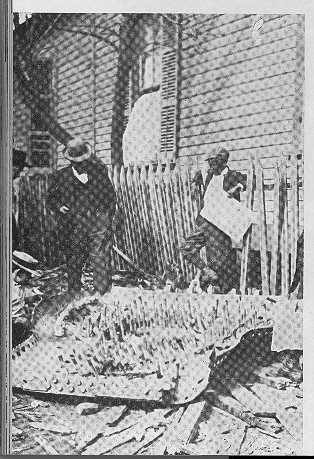
The locomotive boiler and its accompanying equipment, meanwhile had continued to travel upward, being propelled and torn asunder in mid-air by the venting steam. As the pressure finally abated, the pieces, many weighing thousands of pounds, began their individual fall to earth. For blocks in every direction, just as the surface wave passed carrying its debris, the air became filled with falling iron shrapnel, engine parts and human pulp from those unfortunates in the vicinity of the locomotive.
Mrs. Howard, had just left the rear of the house when a falling portion of the crown plate, weighing several thousand pounds, tore away the rear section of the house before burying itself into the ground.
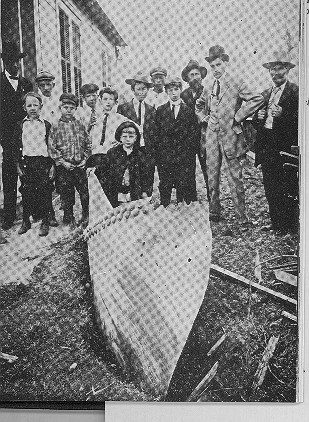
Mrs. Gillis was at her home located nearly seven blocks from the roundhouse when the entire front end of locomotive No.704 began its decent to earth. The mass of iron struck the roof of the Gillis residence and continued through into the ground, crushing what was not shattered. The entire structure was destroyed. Mrs. Gillis’ injuries were considered terminal.
Mrs. Stephens was severely injured when one end of her house was reduced to splinters as a portion of the engine’s water jacket passed through. The transom of a home on River Avenue(now Broadway) was blown out.
The pressure wave of the explosion continued outwards, the effects dissipating with distance from its epicenter. As the wave reached the far West side of the city, miles away, it still retained enough strength to rock buildings, giving the impression of a gas explosion or earthquake and causing people to flee their homes.
As the blast subsided, thousands of people, wherever their location in the city looked towards the Southern Pacific yards where an immense black cloud was moving upwards.
The US Army at Fort Sam Houston responded immediately. Military ambulances began moving towards the yard and a detachment of cavalry was sent to maintain order. City of San Antonio police and fire personnel began to arrive. The first to reach the yard had their hands full.
The North and South Walls of the blacksmith and machine shops as well as the Southwest portion of the roundhouse had been blown to atoms. A third of all the heavy machinery in those shops was either no longer present or was a twisted mass of wreckage. No structure or machine which had stood within a 100 foot radius of No.704 existed. The cooper works, and all the attendant machinery was destroyed. As the walls were blown away, the roofs of the blacksmith and machine shops had collapsed onto the working men.
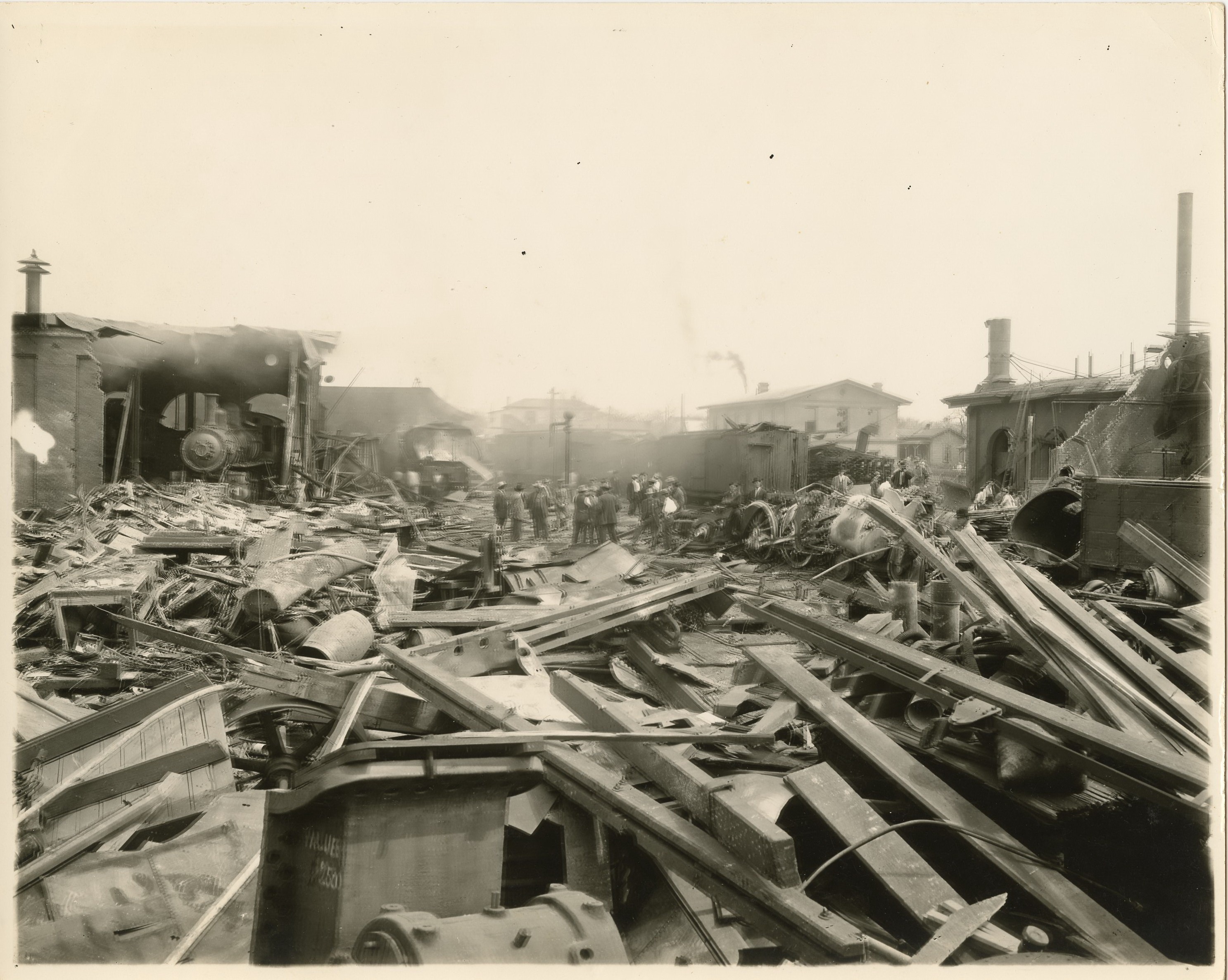
An oil tender, directly behind locomotive No.704, had been thrown end over end for almost 150 feet spraying hundred of gallons of oil over the broken, twisted debris before coming to rest against another locomotive. This oil coating almost immediately caught fire. Those men who had survived the blast, falling buildings and flying iron, injured and trapped under the collapsed buildings and debris were now in danger of being burned alive.
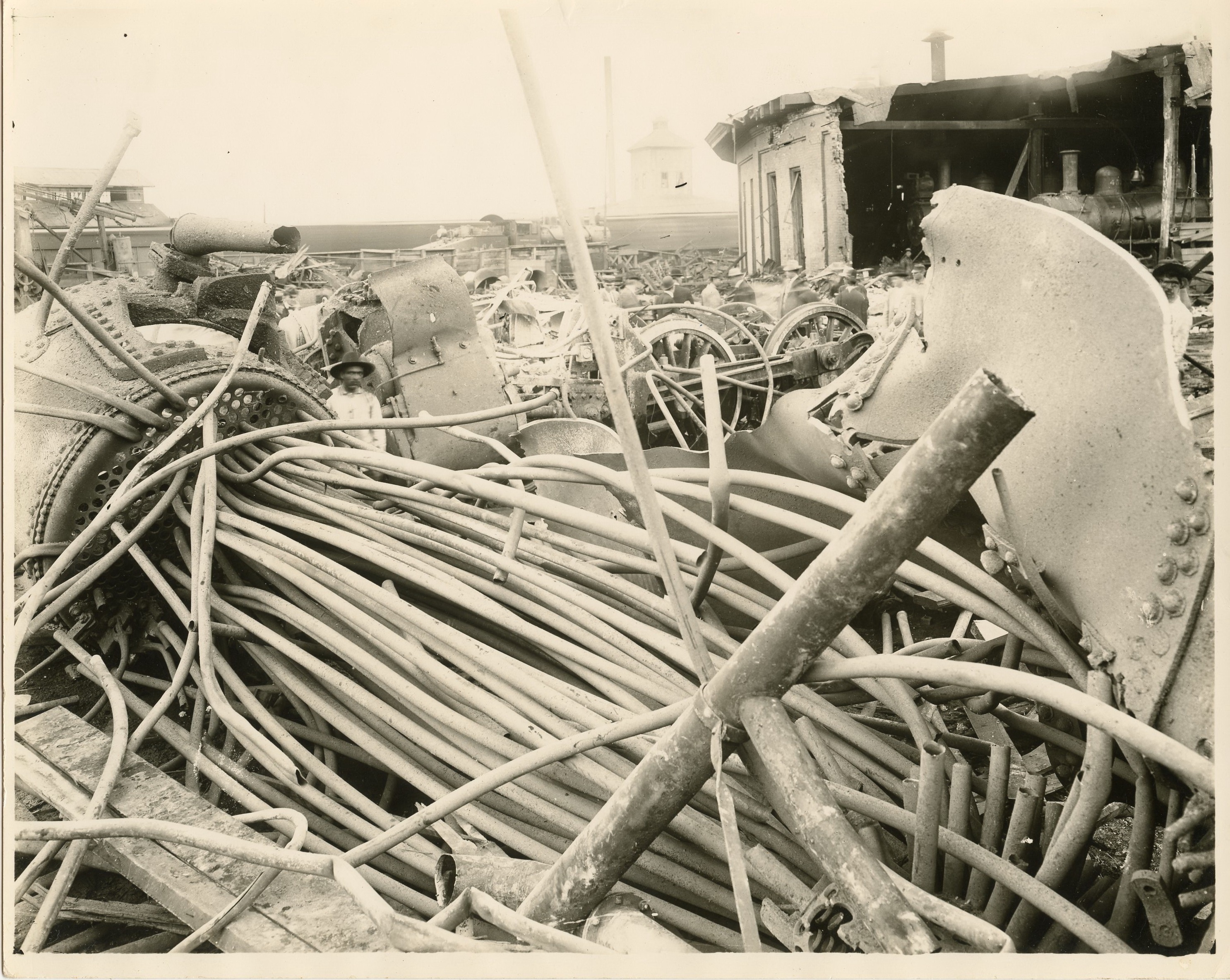
While the fire was being fought, the military medical corpsmen and civilian ambulance personnel, police officers and arriving railroad workers began the long tedious job of locating and in many cases, freeing, the injured men. P.J. Stoudt and two other workers had been blown under a heavy workbench which had held its form when the roof collapsed, saving their lives.
James Mansker regained consciousness laying in the wreckage of the machine shop and although injured began looking for his father. He found the elder Mansker dead in the ruins of the blacksmith shop and took his father’s body home. Archie Price had also been killed, his body would later be identified and claimed at one of the local undertaker’s morgues. Robert Montiel and Jose Fuentes, no longer existed in any recognizable form. The body of James Valentine, the Assistant Roundhouse Foreman was identified by the pistol that he carried. The body of Walter Jourdan the engineer of No. 704 was found in the yard and with some difficulty identified.
Regardless of their individual trauma, both the living and the dead were covered with heavy black oil, their flesh embedded with bits of coal and wood splinters. At least six doctors arrived on the scene and provided initial treatment. The injured were then placed in the horse drawn ambulances and taken to Santa Rosa Infirmary. Three other locomotives in the roadhouse had been heavily damaged. One had its whistle bent open and the entire rescue operation had to be conducted under its continued, full throated scream which lasted for over two hours, until the pressure subsided and the noise slowly, eerily died away.
With the fire under control and the injured carried away, the dead began to be collected. The task was grisly. Almost no body was whole. Most were not recognizable. Body parts were strewn for blocks. Teams were dispatched to walk the residential areas. These two-man teams carried a basket between them covered with a white cloth for collecting the human viscera and body parts laying on the streets and long poles to knock down the pieces hanging from the power lines, poles and trees.
The wife of Carl Cisko, a blacksmith, arrived at the yard and after finding that her husband was dead, simply sat down in front of a nearby store, cradling one of her children and sobbed uncontrollably. Recently arrived in town and speaking no English, she had nothing but the few days pay her dead husband was owed by the railroad to support herself and two children.
As the day wore on, thousands of people from all parts of the city arrived to visit the scene of the disaster. The San Antonio Traction Company, the local street car line, put on extra cars to accommodate the more than 50,000 curious. The Southern Pacific placed guards around its property with instructions to keep the souvenir hunters, ghouls and journalists at bay. Two photographers from the San Antonio Express while attempting to take pictures of the disaster, were roughly handled by the Southern Pacific’s “Special Police”.
As the dead were taken to the morgue’s and the injured to the hospital, the scope of the disaster began to take shape. 26 men were known dead, more than 40 men injured in the yard itself. An exact number of citizens injured or killed was never collected. As many of the strikebreakers were working under assumed names and were from out of town, it will never be known exactly how many were killed. The Southern Pacific Railroad also moved several of the severely injured to the company hospital in Houston within days of the explosion and their fate was never reported locally.
Due to the mangled condition of the bodies, local family members either made a decision to identify and claim a particular portion of a corpse or accepted that their loved one had simply disappeared in the explosion. After a few days, the morgues buried what remained. The mass and weight of human viscera and body parts would indicate that at least ten more men were thereby accounted for. The most accurate estimate of those killed would seem to be no less that 26, probably no more than 40. The injured numbered upwards of 50, including non-railroad persons. The most conservative estimate of the immediate monetary loss, of about a quarter million(1912)dollars, with total losses of approximately three quarters of a million dollars did not include collateral damage to the neighborhood. A total accounting was never attempted.
THE AFTERMATH
On 25 March it was proposed before the City Council of the City of San Antonio that an ordnance be adopted that would create the position of Boiler Inspector and would require examinations before a board to qualify and certify those persons servicing locomotive, fire engine or stationary boilers within the limits of the municipality. The proposal was introduced and read the first time(non emergency proposals had to be read three times)on 25 March. It was read again on the 8th of April, however, there is no indication of a third reading or that the proposal ever became an ordnance. The enforcment of such a proposal would have brought the railroad into immediate conflict with the city. In effect the city would have been qualifying railroad employees.
The lawsuits against the Galveston, Harrisburg and San Antonio Railroad were filed almost immediately in the District Courts in San Antonio.
All the cases were settled without a jury. The life of Archie Price cost the GH&SA Railroad $4,000, paid to his wife Selena. The same amount was paid to Malvina Todd for her husband. Veronike Cisko and the Mansker family had private settlements, the amounts were not recorded.
Beginning the day after the explosion, relief for the widows and orphans of the disaster was being addressed. The Chamber of Commerce appointed a committee to oversee all charitable activities occurring within the city. The investigation, reporting and assignment of need was to be handled by the Associated Charities(AC), the local umbrella organization for all charities in the city. The AC was empowered by the Southern Pacific Railroad to act as its point organization. Mayor Bryan Callaghan quickly endorsed the plan and the AC began its field contacts that day. In a time when government aid was non-existent, the speed and organizational ability shown by private social services is impressive.
Donors and amounts were publicly reported by the newspapers. The newspaper reporting of the progress of the aid to the disaster victims was as careful and in depth as the examination of the disaster itself. The reporting of the destitute circumstances of the victims’ families was heartrending and detailed. Within this daily public forum the social responsibility for providing long term aid to those families that had lost their only breadwinner was acknowledged by local leaders and systematically handled.
THE INVESTIGATION
A board of inquiry was formed the day of the disaster headed by H.F Anderson, Division Superintendent, Southern Pacific Railroad. The committee included the Vice-president of the San Antonio Traction Company, the President and Vice-president of Alamo Iron Works, a local druggist, a US Army Colonel Commanding the United States Arsenal, a Field Artillery Lieutenant, and seven railroadmen, five of whom were senior technicians from systems other than the Southern Pacific. The composition of the committee would seem to indicate an intentional balancing of public and private interests.
While the exact selection process was not detailed in the local newspapers, the presence of senior members of the business community would indicate the involvement of municipal interests, which at this particular time in the history of San Antonio is embodied in the awesome political personage of Mayor Bryan Callaghan. The committee, both in form and membership, could have existed only as a result of mayoral fiat or at least acquiescence. The committee began to hear witnesses that evening, the hearing was public and the local press was present. The next day, the 19th of March, the public committee held hearings for more than five hours, and examined the scene.
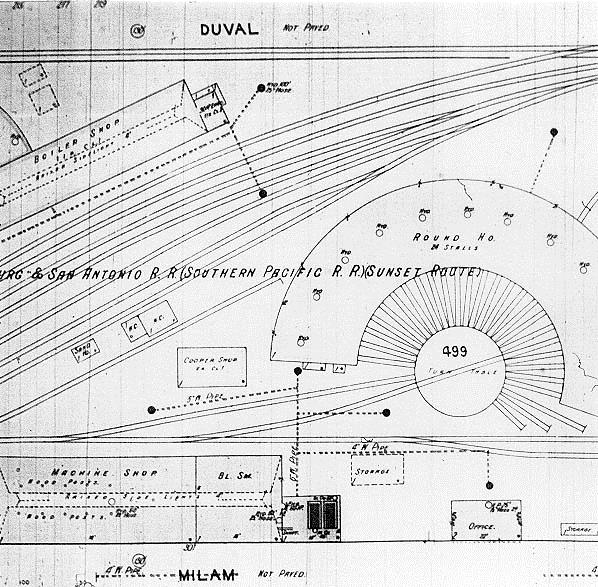
Allison Mayfield, Chairman of the Texas Railroad Commission arrived in San Antonio the evening of the 19th having been requested by the Southern Pacific Railroad. He was accompanied by Railroad Commissioner William D. Williams. Chairman Mayfield stayed at The Menger Hotel and Commissioner Williams at the St. Anthony. Shortly after their arrival Chairman Mayfield was called upon by a group of three men, President Thornwell Fay, President of the Southern Pacific in Texas, H. Garwood, general attorney for the Southern Pacific, and H.F. Anderson the Division Superintendent of the Southern Pacific and head of the public committee investigating the incident. All four then went to speak with Commissioner Williams. Chairman Mayfield had already sent a telegram to Judson C. Clements, Chairman of the Interstate Commerce Commission(ICC), asking that the ICC investigate the incident. The “official” investigation was, however, to be separate from the public committee’s hearings.
On the 20th the public hearings were placed on hold awaiting the arrival of John Ensign, Chief Boiler Inspector and Frank McManamy, Assistant Boiler Inspector of the ICC. Inspector Ensign arrived late on the 21st and began his investigation at the scene. At 10:00 AM on the 22nd, the “official” board of inquiry began closed hearings at the Federal District Courthouse. The public committee was never again convened.
The official board of inquiry was composed of Chief Inspector Ensign, Chairman Mayfield, Assistant Division Superintendent(Southern Pacific RR), J. E. McLean, Assistant General Manager(Southern Pacific RR), J. W. Small, and District Inspectors(Southern Pacific RR), Shirley and Dougherty. The board was assisted by Engineer R.D. Parker of the Texas Railroad Commission, E.B. Roberts, Assistant Attorney General and J. D. Walthall the Acting Attorney General of the State of Texas.
On March 25th, Chief Inspector Ensign returned to Washington, D.C. stating that his report would be submitted to the ICC. Assistant Inspector McManamy stayed in town to conduct tests on several bolts from the Locomotive No.704 that were possibly of inferior condition, if not actually broken, prior to the accident.
Division Superintendent Anderson did make one public statement on the 24th to the effect that as far as his company(Southern Pacific) and its operations was concerned it really did not matter what was concluded by Inspector Ensign or the “official” committee.
Various other persons arrived in San Antonio during the days immediately after the disaster to investigate. The Southern Pacific Railroad had requested that the Texas Labor Statistics Commission send an inspector. Labor Statistics Commissioner J. A. Starling provided an interview to the Austin Bureau of the San Antonio Express after his personal inspection,
“Speaking from forty years experience in this line of work, I am convinced beyond doubt that the occurrence was caused by tremendous boiler pressure. The engine was one of the biggest in the country, and there was not a piece of the boiler as big as that”-here Mr. Starling indicated a small bookcase in his office-“to be found after the explosion. Of course there is no telling just what the pressure was, as the steam gauge was wrecked, or whether there was the proper supply of water, but there is no question that boiler pressure was responsible for this terrible accident.”
Captain Guy M Carelton, Assistant Chief of the Bureau of Explosives of the American Railway Association arrived in San Antonio on the 22d and began his investigation the next day. He and another investigator from the same bureau also met with Chief Boiler Inspector Ensign during their investigation. Captain Carelton’s mandate for conducting his investigation or who might have requested his assistance, was never publicly stated. Carelton did make a public statement, “The main force of the explosion was steam.” When questioned as to contributory causes or collateral forces, he gave no answer.
The men out on strike also appointed a committee composed of machinists to perform their own investigation. Their findings or conclusions do not seem to have been made public.
DISCUSSION AND CONCLUSIONS
What caused the explosion of Locomotive No. 704? There are only three possibilities.
(1) Sabotage.
(2) Human error.
(3) Mechanical failure.
Sabotage – There were labor problems and the strikers had been out of work for months. “Scabs” had been brought in to replace the strikers. The Assistant Roundhouse Foreman was openly carrying a pistol. The strikers were composed of men who certainly knew how to tamper with and neutralize the pressure valves of an engine. One valve is found after the explosion indicating that it was screwed down tight.
That the locomotive’s fireman suddenly “forgot his watch” and had to return home just prior to the explosion and that the repair supervisor was absent and later stated his wife had begged him not to go to work that morning, would seem somewhat suspicious. Neither one was a “scab” and perhaps had been “tipped” that something was going to occur. Both were men who would, of necessity, be on or near the locomotive.
The newspaper reporters were constantly asking the investigators about the possibility of dynamite or the residue of an explosive. That the question was being openly and repeatedly asked would seem to indicate some level of expectancy in the community.
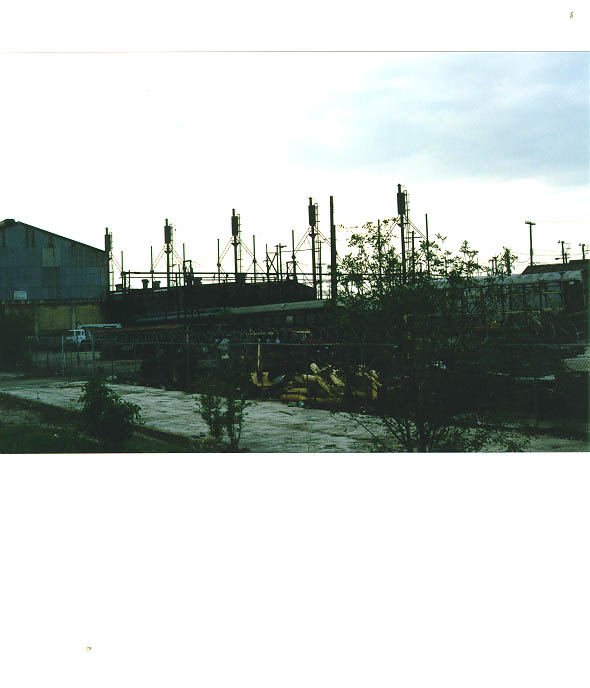
Human error – Locomotive No. 704 had been wrecked and upon repair had shown pressure problems that morning. The initial firing had been “in haste” according to one witness. Firing of the boiler was stopped and the steam pressure allowed to drop. The boiler was then refired and steam pressure allowed to build after orders were issued that the engine had to be in service that afternoon. It was during this second period that the event occurred.
There was pressure of the official kind on the repair facility to get the engine out of the shop and returned to service as quickly as possible. The job knowledge of many of the new men particularly concerning the reporting of pressure problems, was questionable. The type of explosion that occurred was typical in type to what occurs when the boiler is heated with low or no water and then water is suddenly introduced into the boiler.
Mechanical failure – That the internal metal structure of the boiler failed is not in question. Certain pieces of that internal structure may have been weakened in the initial accident, in Seguin, which would not be readily apparent, even upon close observation. The technological knowledge level of metallurgical diagnostics in 1912 must be taken into account.
The GH&SA Railroad paid all claims without going before a jury. This fact alone weighs heavily towards the most likely scenario; the incident was an accident with the GH&SA accepting negligence. If the company could have shown or even suggested sabotage and therefore an act outside their control, it would seem that to do so would have been to their advantage. Even if one were to advance labor relations positioning, i.e., not wanting to reveal an act of labor coercion, as a reason for the company to suppress the evidence of a criminal act, the Interstate Commerce Commission would probably not have shared their perspective and kept silent. While the actions of the Southern Pacific in being part of the subsequent investigations could be viewed as attempting to influence if not control the inquiry, such participation does not provide evidence in favor of any particular one of the three possibilities.
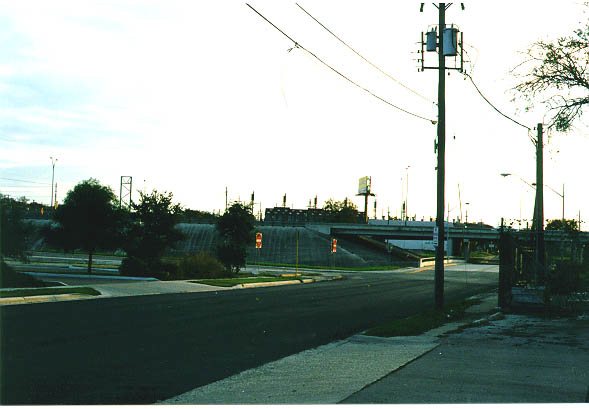
A known or suspected criminal act of sabotage as the cause of the explosion would have necessitated intentional suppression of evidence by the railroad, the Texas Railroad Commission, the Texas Attorney General’s Office and the Interstate Commerce Commission at a minimum. While possible, such conspiratorial mutuality of purpose and inter-organizational cooperation would seem unlikely particularly in a case of what would be multiple murder. An argument based upon the Southern Pacific suppressing evidence in its own self interest must also show why individuals from various other agencies both state and federal would have been convinced to view suppression of multiple murder as being in their respective best interests.
The actual cause or combination of contributory causes will, almost certainly, never be known nor is it necessary. Tragedies occur, it is not the causes that are necessarily interesting, it is the subsequent actions of the various collectives of people impacted by the events of their time that are fascinating and worthy of study.
The immediate intervention by the military, totally outside their legal authority, saved many lives. Doctors providing on-scene aid to stabilize patients before transport certainly reduced the death toll. The immediate and long term aid provided by the social services reduced the suffering. The careful, detailed reporting of the disaster, the subsequent investigation and the progress of the charitable activity, acted as a social binding agent that kept everyone aware and directed towards the necessary goals.
The negation of the public investigation, whether or not by design or influence of the Southern Pacific, by way of an ever increasing state and federal bureaucracy is a portent of the course of our century. A sociological argument could be made that this was an excellent example of the ascendancy of the developing governmental-industrial organizational structure over the participatory-voluntary associations of progressive era urban America.
This event is not the same type of tragedy as the Triangle Shirtwaist factory fire that had occurred the year before on March 25th in New York City. At that fire, 146 people, mostly young girls, burned to death, trapped in a sweatshop. The owners were accused of locking the doors in order to keep their employees inside and at their machines. After the fire, pressure from local labor unions and the very real possibility of repeated occurrences forced the city administration to take various comprehensive fire control and safety actions. The owners were tried and found not guilty on one count of negligent homicide of a dead male caretaker and after subsequent indictments were quashed by the New York Supreme Court no one was every found to be at fault. The girls, while technically employees, were viewed by the newspapers as labor slaves and murdered victims of the sweatshop system. Neither is the San Antonio event the same as the great maritime disaster that was to occur within a few weeks. On 14 April, 1912, R.M.S. Titanic, a White Star steamship, struck an iceberg in the North Atlantic and sank with a loss of 1,523 lives. The subsequent investigations both in the United States and Great Britain resulted in basic changes to lifeboat regulations and the shifting of the sea lanes further south. Again, a great number of innocent persons, women and children were killed. They were not viewed as having accepted any employment risks.
In San Antonio, the victims were almost all workers, killed in what today would be termed an industrial accident. It is difficult to perceive the level of hazard faced by a railroad employee of that time. 72,000 employees were killed and 2 million injured on the tracks between 1890 and 1917, 158,000 more were killed in repair shops and roundhouses. In just this 27 year period the railroad industry had 2,230,000 casualties. In all its wars combined, from the Revolution to the Persian Gulf, over 200 years, the United States has suffered only 2,427,094 casualties.
That Superintendent Anderson, an employee of the Southern Pacific might have a conflict of interest when acting as the head of the public board of inquiry was apparently never considered or if so, it certainly was not voiced. However, if the event is seen as an industrial accident such as a mine disaster, Anderson’s selection seems less odd. That four of the six members of the second board of inquiry were also employees of the Southern Pacific, again apparently bothered no one.
Once a federal officer had arrived the entire investigation became his. The deference to authority, both federal and state is obvious. Almost as much so as the deference given to the “experts” who seemed to arrive in town unbidden, were allowed access to the evidence, performed their investigations and then departed with little return to the local community. If and when a public report was to be made by the federal government seemed to be of little concern to the newspapers. The media seemed to possess no need or drive to question the activities of the government officials. It was apparently felt that if action needed to be taken the government would do so. It was most certainly a different time.
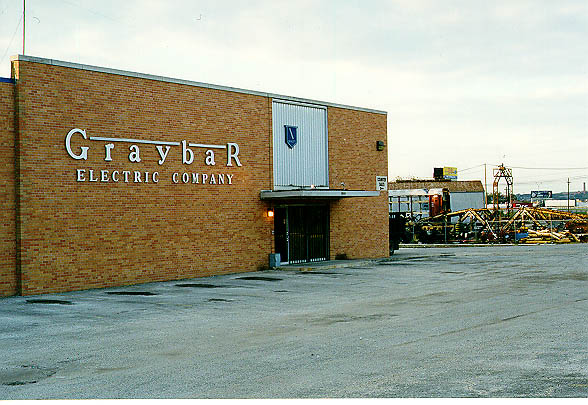
The great locomotive explosion is worthy of study from a number of sociological and historical perspectives. For both urban sociologists and social historians it is an excellent example of a stress reaction within a post-Victorian/Progressive Era urban social system. The systemic patterns of a developing bureaucracy should also be of interest to organizational theorists. Both conflict theorists and structural fundamentalists can find much to support their particular perspectives. The event surrounding Locomotive No.704 is fertile ground.
AFTERMATH IMAGES
